Preferences
General
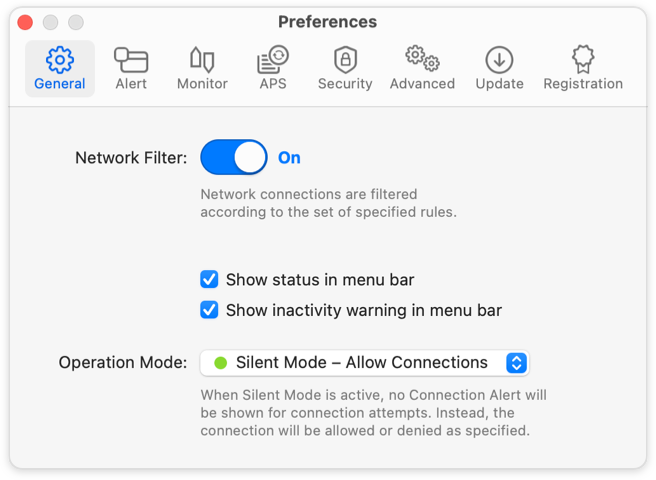
- Network Filter — You can turn off the entire network filter here. This can be helpful if something does not work as expected and you want to know whether one of your Little Snitch rules is the cause. In demo mode, without a valid license, Little Snitch deactivates the filter every three hours and you need to manually turn it on again. It can also be turned on via the status menu.
- Show status in menu bar — Choose whether the status menu shall be displayed.
- Show inactivity warning in menu bar — With this option turned on the status menu displays a yellow warning triangle when the network filter is off.
- Operation Mode — Choose between Alert Mode and Silent Mode here. This option can also be changed in the status menu.
Alert

- Detail Level — How many details about the connection are shown by default and how many rule creation options are shown. Having too many details distracts from the relevant information, but some people prefer to see them. Whatever you choose here, when you click the Connection Details button, all details are shown and all rule creation options become available.
- Preselected Options — People have preferences what type of rule to create when a connection alert is shown. Some prefer to make all rules temporary in the first place, some make domain rules only, while others always make their rules as specific as possible. Here you can decide what the defaults are, so that you can quickly create your preferred type of rule.
- Confirm connection alert automatically — When you use “Back to my Mac” to log in to your computer remotely, it is frustrating to be locked out just because Little Snitch is stalling your login, waiting for somebody to answer a connection alert, but nobody is at home. You could answer it yourself, if you could get around this single first alert… When you set up an alert timeout, you can answer alerts while you are in front of your computer and have them allowed or denied automatically with default settings when you are away.
- Confirm with Return and Escape — Whether Allow and Deny can be triggered via keyboard. Some people prefer to use the mouse only, because they may be typing text when the alert appears, typing Return or Escape accidentally. Note that Little Snitch ignores keystrokes for the first second after the alert appears to catch most of these accidental keystrokes.
Network Monitor
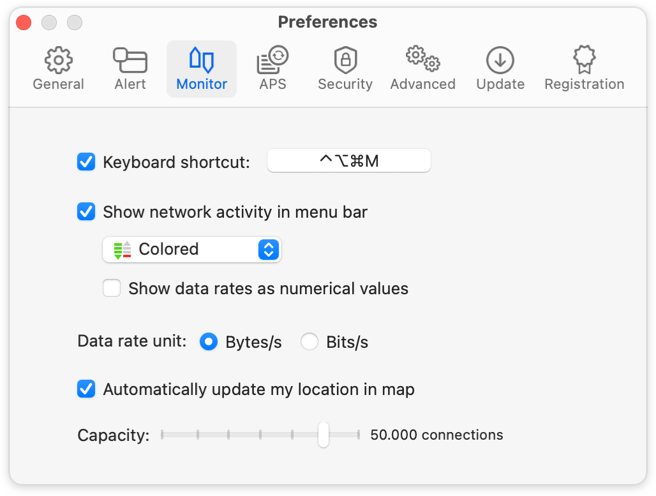
- Keyboard shortcut — A global keyboard shortcut to show and hide Little Snitch Network Monitor.
- Show network activity in menu bar — Whether the status menu icon should display current data rates and blocked connections.
- Show data rates as numerical values — With this option turned on the status menu shows numerical data rates in addition to the traffic meter.
- Color scheme — Whether to display traffic rates in color (red for upload, green for download) or monochrome.
- Data rate unit — The unit in which data rates are displayed in the status menu or in Network Monitor – either Bytes per second (B/s) or Bits per second (bps).
- Automatically update my location in map — Whether to use Apple Location Services to determine where the My Location mark is drawn. For privacy reasons, Little Snitch determines your current location from your Language and Region Preferences by default. It places My Location in the middle of the country configured there.
- Capacity — Little Snitch stores statistics for all connections with distinct properties (see section [How can we identify a connection?]). There is no time limit, so the amount of data stored could eat up your computer’s resources. We therefore limit the number of connection statistics stored. If the limit is exceeded, the oldest connections for each process are merged into an Older Connections entry so that we collect at least the total statistics for each process. The number you configure here is not the total number of (expanded) rows in the connection list because each row represents a class of connections (with potentially different ports and Internet addresses).
Automatic Profile Switching
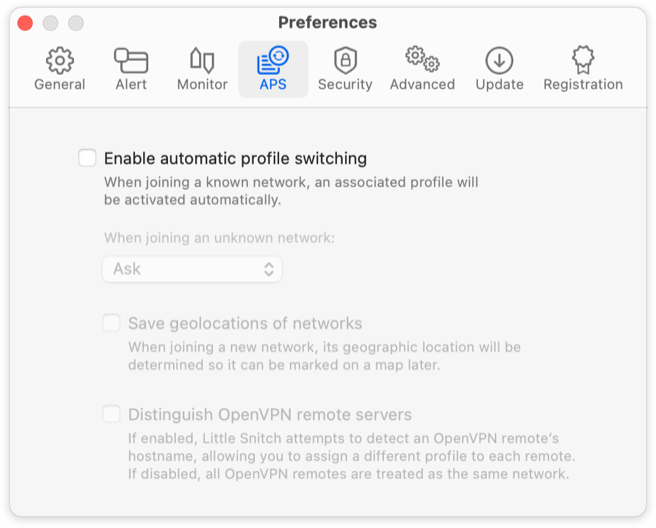
- Enable automatic profile switching — Whether automatic profile switching is enabled at all.
- Default action — When you join a network not yet known to Little Snitch, it shows a New Network Alert. This may be annoying if you are traveling a lot, connecting to new networks often. With this option, you can set a default action which is performed instead of showing an alert. If you really want to assign a specific profile to a new network (which differs from the default), you need to do it manually.
- Save geolocations of networks — The list of known networks contains all the technical details stored for each network, but the names may be cryptic, so you often cannot remember which network is which. Little Snitch can store geographic coordinates for each network, which makes them easier to identify. The information is determined via Apple Location Services.
- Distinguish OpenVPN remote servers — If enabled, Little Snitch attempts to detect an OpenVPN remote's hostname, allowing you to assign a different profile to each remote. If disabled, all OpenVPN remotes are treated as the same network.
Security

Security preferences are locked by default. You need to click the lock in the bottom left corner and enter an Administrator password in order to make changes.
- Allow-rule and profile editing — If you have managed accounts (e.g. for your children) on your computer, you may want to forbid users to edit rules and profiles. In order to make changes, you need to temporarily enable editing. The Rules Window offers quick access to this option in the bottom left corner of Little Snitch Configuration. When a connection alert is shown while rule and profile editing is disabled, only temporary rules can be created.
- Allow profile switching — Whether users may switch profiles. This option is always on if the previous option is on.
- Allow preferences editing — Whether users may change preferences. Useful if you have managed accounts (e.g. for children) on your computer. Users who have authorized as Administrator by clicking the lock may still edit preferences or re-enable this option.
- Allow Global Rule Editing — Whether users are allowed to create rules for Anyone. Since these rules affect other users, there is an option to prohibit their creation. Note, however, that System rules also affect other users and editing them must be allowed to all users.
- Allow access via Terminal — Little Snitch comes with a Terminal command
littlesnitch. In order to prevent malicious scripts from manipulating your firewall settings, most of the functions of this command are only available to the superuser and only if enabled here in the settings. - Hide my connections from other users — Decide whether Network Monitor may display domain and host details for apps running under your account to other users on the computer. Note that your apps may delegate tasks to system processes which service all accounts and are therefore visible to all users.
- Allow GUI scripting access to Little Snitch — Whether it is allowed to remote-control Little Snitch. It is obvious that allowing remote control undermines some of the security gained by Little Snitch, but you may need it for third party screen sharing applications, assistive devices or similar.
Advanced
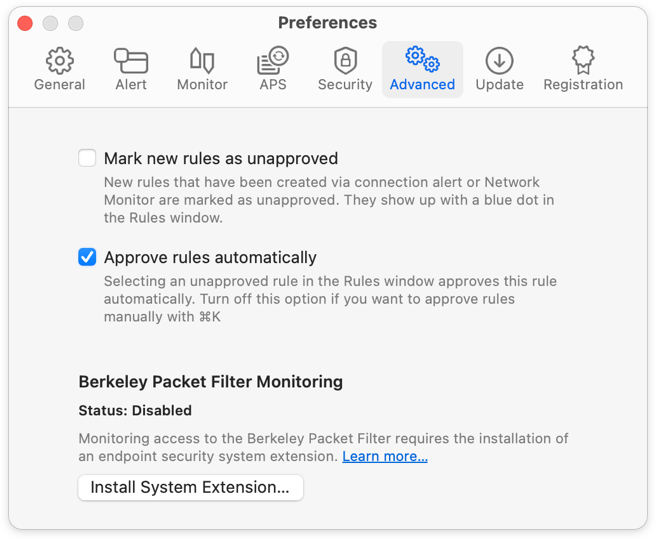
- Mark rules from connection alert as unapproved — Little Snitch Configuration marks unapproved rules with a blue bullet. It indicates that these rule were created outside of Little Snitch Configuration and you may want to review them. When this option is set, the connection alert creates rules with this unapproved-status.
- Approve rules automatically — When this option is set, the unapproved-status is automatically removed from rules when you select them in Little Snitch Configuration. If it is not set, you need to approve rules manually, e.g. by clicking the Approve button in the top bar of the Unapproved Rules sidebar filter or by editing them (even when you cancel the Rule Editor).
Software Update
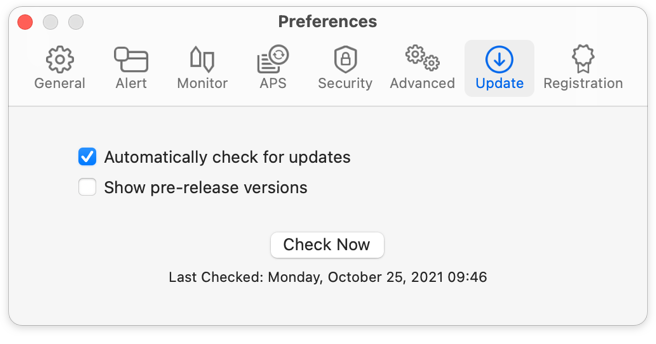
- Automatically check for updates — Whether Little Snitch should contact
sw-update.obdev.atevery day and check for new versions. Strongly recommended, in order to benefit from security updates! Failing to install a security update in a timely manner may leave your computer vulnerable to attacks. If you have a pre-release version installed (beta, nightly build or similar), this option is always on. - Show pre-release versions — Whether you want to be notified about betas, nightly builds and similar. Always on in pre-release versions.
Registration
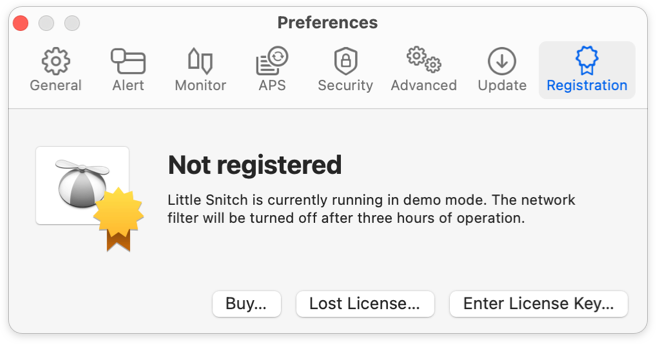
You can view your license properties here, enter a license key or be redirected to our website.
Was this help page useful? Send feedback.
© 2016-2026 by Objective Development Software GmbH